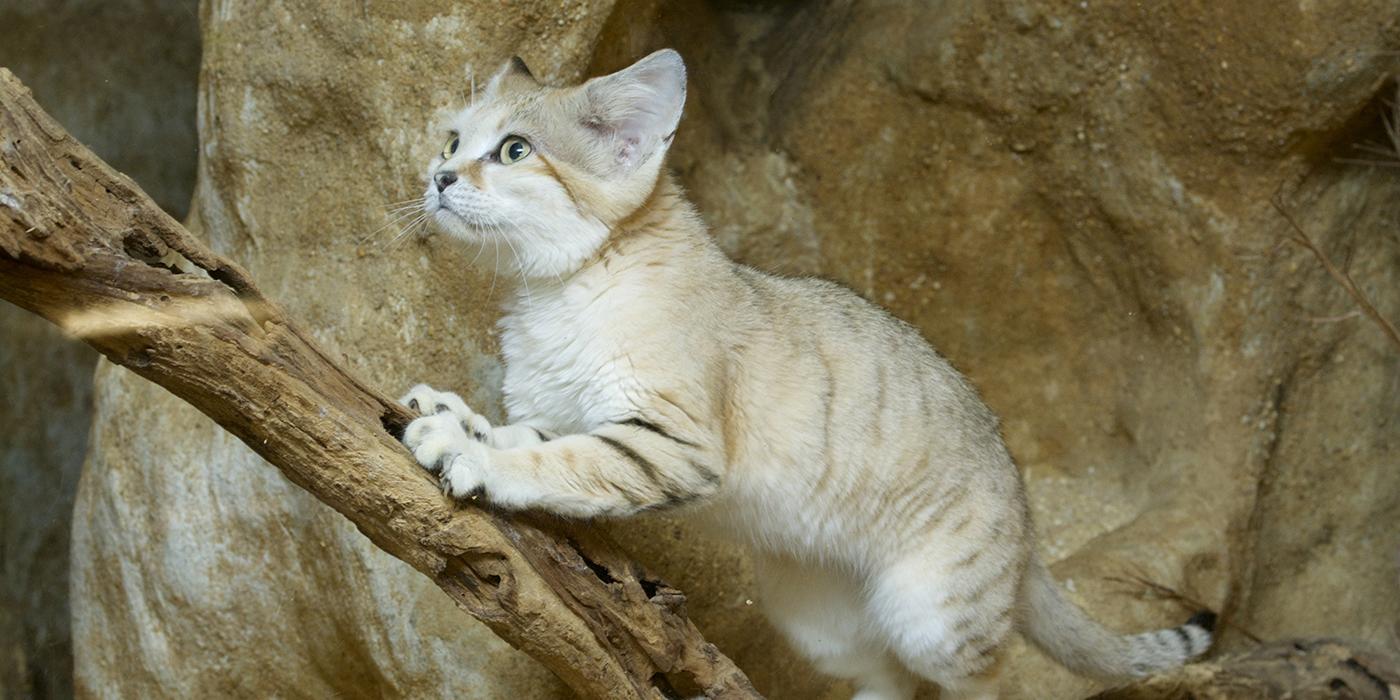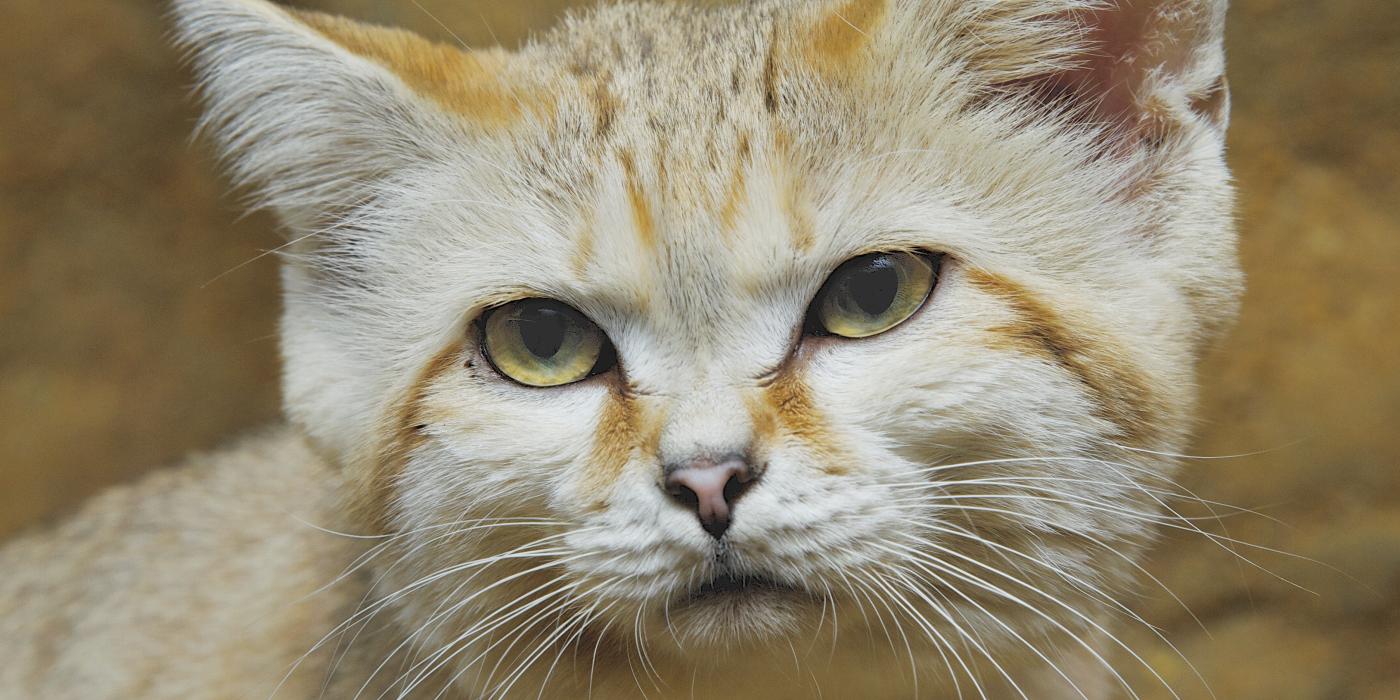Can Sand Cats Survive Without Water? And Other Questions, Answered
With their big ears, wide eyes and furry paws, sand cats may look adorable… but they’re quite tough! Sand cats are the only members of the cat family to live exclusively in desert environments. Get to know these hardy felines in the Q&A below.
Can sand cats survive without water?
The desert environments where sand cats live are some of the harshest ecosystems on Earth. Daytime temperatures can easily top 115 degrees Fahrenheit (46 degrees Celsius) in the warmest months of the year and plummet to -25 degrees Fahrenheit (-31 degrees Celsius) on cold winter nights.
Many desert species—including sand cats—have a variety of physical and behavioral adaptations that enable them to live in such extremes. Among those is the ability to survive for months at a time without drinking water.
Sand cats get nearly all the hydration they need from their prey; the animals they hunt have moisture contained within their bodies, and that’s usually enough to keep sand cats going. However, your average sand cat probably wouldn’t pass up the opportunity to sneak a few sips of water after a rare desert rainfall.
Why are their paws so big?
Big paws come in handy! Sand cats avoid extreme temperatures by creating burrows and tunnels into the sand, and flat, shovel-like paws help them dig more efficiently. Unlike their domestic cousins, the footpads of sand cats have a layer of fur that allows them to walk on hot sand without burning their paws. Finally, their wide feet displace their weight so efficiently that they barely leave footprints in the sand, making it difficult for larger predators to track them across the desert.
How do they survive in the desert?
Sand cats are built to handle extremes. Traveling up to 5 miles (8 kilometers) per day in the wild, sand cats make the most of their adaptations. Special coats insulate their bodies during freezing cold nights and release heat during blazing hot days. Their big ears and wide paws help dissipate heat when the temperature gets too hot. If the weather starts to push the limit of their endurance, they will dig burrows and hang out underground to escape the sun’s rays.
Where are they found?
Sand cats are native to remote sandy and rocky desert regions in Africa and Asia. Populations are found in the northern Sahara desert, the Arabian peninsula and some parts of western and central Asia, including the countries of Iran, Pakistan, Uzbekistan and Turkmenistan.
How big are they?
A bit smaller than a house cat. Adult sand cats weigh between 3 to 7.5 pounds (1 to 3.5 kilograms). Nearly half of their body length is from their tails—which sometimes reach 11 to 14 inches (28 to 35 centimeters) long!
Are they dangerous to humans?
Not really. Although sand cats tend to be a bit feistier than your average house cat, sand cats are unlikely to attack animals much bigger than them. And because these felines are found in environments that are so inhospitable to human life, encounters between people and sand cats do not occur often.
What do they eat?
As carnivores, sand cats prey on whatever small animals they can find in the desert, including small rodents, hares, birds, spiders, insects and reptiles. They are even known to eat venomous snakes within their range. They eat about 10 percent of their body weight per day; for an average adult human, that’s the equivalent of eating 15-20 pounds (7-9 kilograms) of food per day!
To smaller animals, sand cats can be quite fearsome. Sand cats use their big ears to pick up sounds from prey animals scurrying in the sand. Tan coloring helps them blend into their surroundings. They approach their prey by sneaking and staying hidden, keeping their bellies low to the ground. When it’s time to attack, sand cats are remarkably quick—in short bursts, they can run up to 25 miles (40 kilometers) per hour.
What do they sound like?
Sand cats are normally very quiet, but they’re capable of vocalizing. To attract potential mates from faraway distances, they make growling calls that could easily be confused with a barking dog. And like domestic cats, they can meow, purr, growl and hiss when they need to.
Do sand cats make good pets?
Despite their resemblance to house cats, sand cats are not, and have never been, domesticated. As true wild cats, they are not adapted for living alongside humans. Occasionally people do attempt to keep them as pets; however, their respiratory tracts are specialized for extremely dry environments and are prone to illnesses (like sinus infections) outside of the deserts where they naturally live.
The sand cats at the Smithsonian’s National Zoo and Conservation Biology Institute are certainly lovable—but challenging to take care of! Sand cats urinate to mark their territory, so their exhibit areas need to be cleaned often. They love to chew up and hide their food, and keepers often find the guts of mice and traces of meat around their enclosures. And like house cats, they have sharp nails... which they frequently sharpen on exhibit furniture.
Our recommendation? Caring for these adorable felines is a job best left to professionals.
How many sand cats are there? Are they endangered?
Unknown! Sand cats live solitary lives and are often separated by dozens of kilometers. Scientists don’t believe they are threatened, but these cats are so elusive and live in such remote environments they’re hard to study.
Want to catch a glimpse of these elusive desert dwellers? Stop by the Small Mammal House and see a sand cat during your next visit to the Smithsonian’s National Zoo and Conservation Biology Institute in Washington, D.C.!
Related Species:

